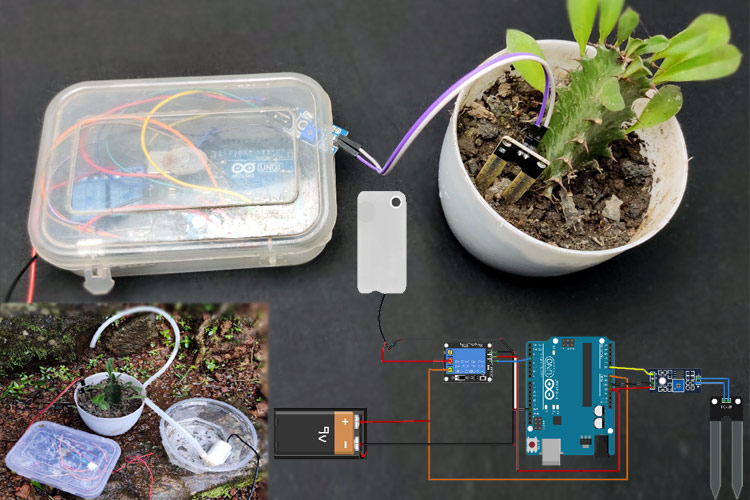Automatic Irrigation System using an Arduino Uno

Everyone of us likes a little greenery in our houses, don’t we? Plants require really low maintenance and can be left for days without supervision but our long trips extending over a week or 2 can be detrimental for the health of plants due to the lack of moisture in the soil. In such situations, the plant may wither or die due to the absence of proper watering. In order to solve this problem, in this project, we are making an Automatic Irrigation System with an Arduino Uno which will irrigate your plants automatically and keep them healthy even when you are out of the town for weeks or months. In this project, a Moisture sensor will be used to maintain the optimum level of moisture for your plants. This system can be implemented, both for your garden or for your Indoor plants thus taking care of your leafy pets when you are away. If you are a beginner you can also read our Arduino Soil moisture sensor tutorial to understand the basics before you proceed with this tutorial.
We also build low cost IoT based Soil Moisture Monitoring Device, you can check out the demonstration video given below.
Working of the Automatic Irrigation System
The logic of this system is very simple. In this system, the moisture sensor senses the moisture level of the soil and when the sensor senses a low moisture level it automatically switches the water pump with the help of a microcontroller and irrigates the plant. After supplying sufficient water, the soil gets retains the moisture hence automatically stopping the pump.
Soil Moisture Sensor

The working of the soil moisture sensor is very easy to understand. It has 2 probes with exposed contacts that act like a variable resistor whose resistance varies according to the water content in the soil. This resistance is inversely proportional to the soil moisture which means that higher water in the soil means better conductivity and hence a lower resistance. While the lower water in the soil means poor conductivity and will result in higher resistance. The sensor produces an analog voltage output according to the resistance.
The sensor comes with an electronic module that connects the probe to the Arduino. The module has an LM393 High Precision Comparator which converts the analog signal to a Digital Output which is fed to the microcontroller. We have covered an in-depth Arduino soil moisture sensor tutorial which covers the working of soil moisture sensor module and how to use it with the Arduino. You can check the tutorial if you want to learn more about the soil moisture sensor.
Pump

We need a small pump to irrigate the plant, but in the case of a garden, we need to drive a larger pump that can provide a higher volume of water depending on the size of your garden which can’t be directly powered by an Arduino. So in case you need to operate a larger pump, a driver is necessary to provide enough current for the pump, to show that I am using a 5v relay. You can also use an AC-powered pump and use a suitable relay. The working will remain the same as shown in this project, you just have to replace the DC power input connected to the relay with an AC power input and have to power your Arduino with a separate DC power source.
Components Required for the Automatic Irrigation System
The project requires very few components and the connection is also very simple. The components are listed below:
- Arduino * 1
- moisture sensor * 1
- 5v relay module * 1
- 6v Mini water pump with small pipe * 1
- Connecting wires
- 5v battery * 1

Circuit Diagram of the Arduino Automatic irrigation system
The complete circuit diagram for the Arduino Automatic irrigation system is shown below:
In this section, I will explain all the details with the help of the schematic diagram. The Arduino UNO is the brain of this whole project. It controls the motor pump according to the moisture in the soil which is given by the moisture sensor.
To power the circuit, I am using an external Battery. You can use any 9v or 12-volt battery. The battery is connected to the Vin and ground pins of Arduino and we can also connect the motor to this battery via a relay. Moisture sensor output is connected to the analog pin of Arduino. Do remember to use the Arduino’s 5volt pin to power the sensor and relay module.
Assembling the Automatic Irrigation System
Let’s start with connecting the relay to the Arduino board. Connect the VCC of the relay module to the 5v pin of the Arduino and connect the ground of the relay to the ground of Arduino. Now connect the relay signal pin to any digital pin of Arduino except pin 13. Here I have connected it to pin 3 as shown in the image below.

The next step is to connect the soil moisture sensor with the Arduino. Connect the VCC and gnd of the sensor to the 5volt and ground pin of the Arduino. The analogue output of the sensor connects to any analogue pin of the Arduino, here I’ve connected it to pin A0 (according to our program).

Finally, connect the pump to the relay module. A relay module has 3 connection points which are common, normally closed, and normally open. We have to connect the pump positive to common and connect the normally open pin to the positive of the battery. You have to select the battery as per your pump. The next step is to connect the ground of the pump to the ground of the Arduino and finally, connect the small hose to the water pump.
Now connect the battery to the circuit and if the pump starts working then your circuit is okay. Now let’s upload code to Arduino.

